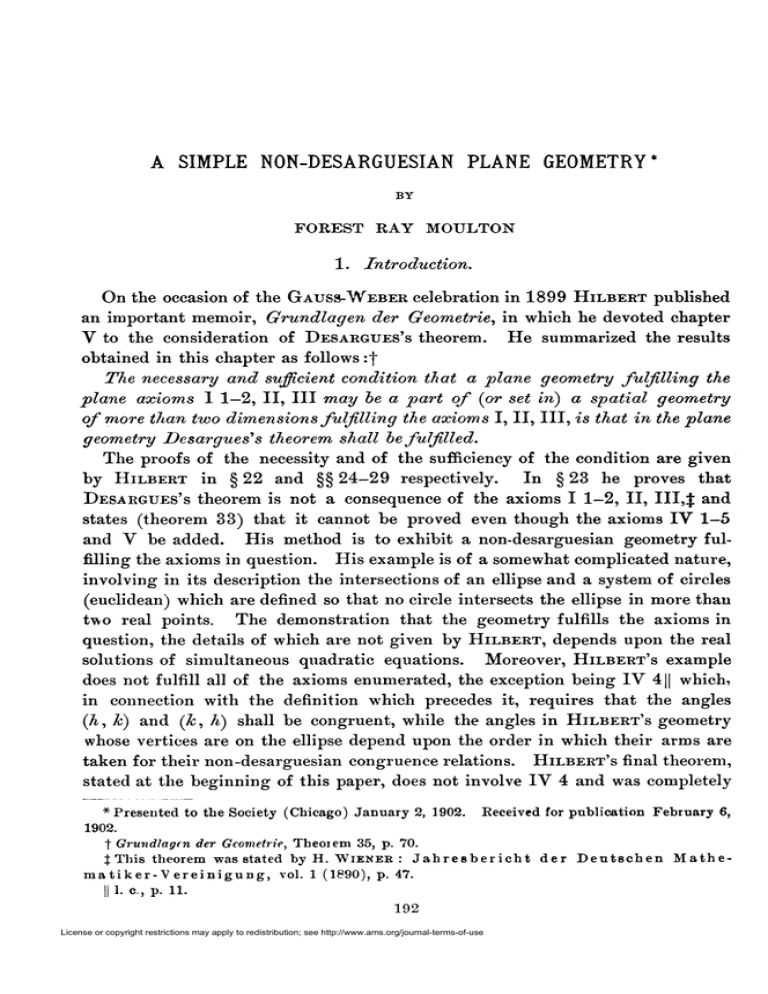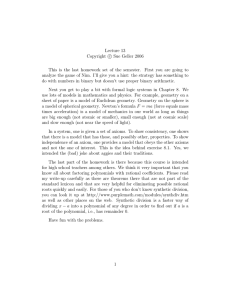A SIMPLE NON-DESARGUESIAN PLANE GEOMETRY*
advertisement

A SIMPLENON-DESARGUESIAN PLANEGEOMETRY* BY FOREST RAY MOTJLTON 1. Introduction. On the occasion of the Gauss-Weber celebration in 1899 Hilbert published an important memoir, Grundlagen der Geometrie, in which he devoted chapter V to the consideration of Desargues's theorem. He summarized the results obtained in this chapter as follows :f The necessary and sufficient condition that a plane geometry fulfilling the plane axioms 1 1—2, II, HI may be a part of (or set in) a spatial geometry of more than two dimensions fulfilling the axioms I, II, III, is that in the plane geometry Desargues's theorem shall be fulfilled. The proofs of the necessity and of the sufficiency of the condition are given by Hilbert in § 22 and §§ 24-29 respectively. In § 23 he proves that Desargues's theorem is not a consequence of the axioms I 1-2, II, III,f and states (theorem 33) that it cannot be proved even though the axioms IV 1—5 and V be added. His method is to exhibit a non-desarguesian geometry fulfilling the axioms in question. His example is of a somewhat complicated nature, involving in its description the intersections of an ellipse and a system of circles (euclidean) which are defined so that no circle intersects the ellipse in more than two real points. The demonstration that the geometry fulfills the axioms in question, the details of which are not given by Hilbert, depends upon the real solutions of simultaneous quadratic equations. Moreover, Hilbert's example does not fulfill all of the axioms enumerated, the exception being IV 4|| which, in connection with the definition which precedes it, requires that the angles (h, k) and (¿, h) shall be congruent, while the angles in Hilbert's geometry whose vertices are on the ellipse depend upon the order in which their arms are taken for their non-desarguesian congruence relations. Hilbert's final theorem, stated at the beginning of this paper, does not involve IV 4 and was completely * Presented to the Society (Chicago) January 2, 1902. Received for publication February 1902. t Grundlagen der Geometrie, Theoiem J This theorem matiker-Vereinigung, 35, p. 70. was stated by H. Wiener : Jahresbericht vol. 1 (1890), p. 47. Il1. c, p. 11. 192 License or copyright restrictions may apply to redistribution; see http://www.ams.org/journal-terms-of-use der Deutschen Mathe- 6, F. R. MOULTON: A SIMPLE NON-DESARGUESIAN PLANE GEOMETRY 193 established ; his theorem 33 (1. c, p. 51) which adds the axioms IV 1-5, V is also true, as will be shown later, but was not fully proved by his example. The object of this paper is to prove that Desargues's theorem is not a con- sequence of Hilbert's axioms I 1-2, II, III, IV 1-5, V by exhibiting a sim- pler non-desarguesian plane geometry than that given by Hilbert, and one which, by the use of linear equations alone, can be shown to fulfill all of the axioms in question. In conclusion it will be shown that Pascal's theorem is not true in this geometry. Hence Pascal's theorem is not a consequence of the axioms I 1—2, II, III, IV 1-5, V. Hilbert has proved that it is a consequence of the axioms I 1-2, II, HI, IV (1. c, § 14), * and also that it is a consequence of I, II, III, V, but that it is not a consequence 2. Description ofl, II, III (1. c, chapter VI). of the non-desarguesian geometry. The non-desarguesian geometry will be described in terms of ordinary euclidean plane geometry, which is assumed logically to exist. *Schur (Mathematische Annalen, vol. 51, 1899, p. 401) had previously proved the fundamental theorem of protective geometry (and so Pascal's theorem) without the use of a continuity axiom, but with the use of three dimensions. Cf. Schur, Ueber die Grundlagen der Geometrie (1. c., vol. 55, 1901, p. 265). License or copyright restrictions may apply to redistribution; see http://www.ams.org/journal-terms-of-use 194 F. R. MOULTON: A simple [April An ordinary euclidean plane in which there is a system of rectangular axes is the non-desarguesian plane ; the euclidean points of this plane are the non-desarguesian points ; the euclidean straight lines, except those which have a positive slope, are non-desarguesian straight lines ; the euclidean (broken) straight lines with positive slope broken at the x-axis so that the slope above is a positive constant (not unity) times the slope below are the remaining non-desarguesian straight lines. That is, the non-desarguesian straight lines are the euclidean straight lines parallel to the x- and y-axes and the euclidean (straight or broken) lines defined by the equation v KÁx~a)tan 6- Here x and y are the rectangular coordinates of a point referred to the given axes, a is the distance from the origin to the point where the line crosses the x-axis, 6 (0 ^ 9 < 7r) is the angle between the positive end of the x-axis and the prolongation of the lower half of the line, and 8y 0 is a constant such that 8 e = 1 if y < 0, 6 = any value, or if y > 0, 6 =utt/2 , and 8y e = c (c > 0 and c =)=1) if y > 0 , 6 <tt/2.* Thus, in the figure, the lines AXKM, BXB2P, CXC2P, Oy and Ox are non-desarguesian 3. Properties straight lines. of the non-desarguesian geometry. Hilbert's axioms I 1—2 relate to the unique determination of a line by any two of its points ; it is easily seen that they are fulfilled in this geometry. The axioms II 1—4 relate to the ordering of three and four points upon a line ; the order relations are taken as in euclidean geometry and these axioms are fulfilled. The axiom II 5 states that a straight line cutting one side of a triangle and not passing through one of its vertices cuts another side of the triangle ; it is shown without difficulty that this axiom is fulfilled. The axiom III is the euclidean parallel axiom which is also fulfilled in this geometry. The axioms IV 1—3 relate to the congruence of segments of straight lines. If the segments are measured along the lines in this geometry as they are in euclidean geometry these axioms are fulfilled. The axioms IV 4—5 relate to the congruence of angles, and, with appropriate determination of the circumstances under which two angles are called congruent, these axioms are fulfilled. It will he the simplest here to define the magnitudes of angles in terms of euclidean angular magnitudes, and then those angles as congruent which have equal magnitudes. In this geometry the non-desarguesian magnitudes of all angles are equal to their euclidean magnitudes except those which have their vertices on * To fix the ideas c may be taken that the figure is drawn. equal to one-half, and it is for this value of the constant License or copyright restrictions may apply to redistribution; see http://www.ams.org/journal-terms-of-use 1902] NON-DESARGUESIAN PLANE GEOMETRY 195 the x-axis with at least one arm above it and making an angle (euclidean) of less than tr/2 with it. The point K being on the x-axis, we consider the angle LKM of divergence from the positively directed x-axis of a line KM of the upper half-plane. The non-desarguesian magnitude of this angle is the euclidean magnitude of the angle which in the non-desarguesian sense is vertically opposite to it. Thus, in the figure the non-desarguesian magnitude of the angle LKM equals the euclidean magnitude of the angle OKA2 or LKP. The nondesarguesian magnitude of an angle between two lines intersecting on the x-axis is the algebraic difference of the non-desarguesian angles which they make with the x axis. With these definitions the axioms IV 4-5 are fulfilled. The axiom IV 6 relates to the congruence of triangles and is fulfilled neither in Hilbert's geometry nor in this. The axiom V (archimedean) is fulfilled both in Hilbert's geometry and in this. It remains to show that Desargues's theorem is not true in this geometry. Consider the special case of two triangles having their corresponding sides respectively parallel. It will be shown that the lines joining their corresponding vertices are not necessarily concurrent. In the figure let the triangles be AXBXCX and A2B2C2. In euclidean geometry the lines joining the corresponding vertices meet at the point P. In this geometry the lines Bx B2 and Cx C2 remain the same while the line AXA2 is broken before reaching P. Hence it will no longer pass through P, and Desargues's theorem is not fulfilled. Therefore Desargues's theorem is not a consequence of Hilbert's axioms I 1-2, II, III, IV 1-5, V. To prove that Pascal's theorem is not true in this geometry consider the two lines p and q on opposite sides of the x-axis and choose the points Px, P2, P3 and Qx, Q2, Q3as indicated in the figure. In euclidean geometry the crossjoins of these points taken in pairs meet in the collinear points Hx, P2, K3. In this special geometry all the cross-joins are the same as in euclidean geometry, with the exception of Qx P3 which is a broken euclidean line intersecting the line Px Q3 in the point P2. Since the euclidean line passing through Kx and R3 has a negative slope it is also the non-desarguesian line passing through these two points. As JR'2 is not on this line Pascal's theorem is not true in this geometry. Therefore Pascal's theorem is not a consequence of Hilbert's axioms I 1-2, II, III, IV 1-5, V. The University or Chicago, February 5, 1902. License or copyright restrictions may apply to redistribution; see http://www.ams.org/journal-terms-of-use



